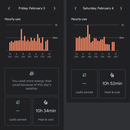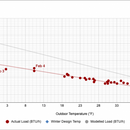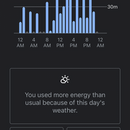Sizing New HVAC System
Greetings…
I’ve been planning for an hvac replacement over the last few months and this has given me time to get a sense for how my old equipment is working during the winter season. (Moved into this house in the summer of ’22). Thanks to forum user akos_toth for encouraging me to hang on to my old equipment for my first winter to get this baseline.
I’ve been tracking my heat load using my old single-stage furnace’s runtimes. We recently had a cold snap (low of -13F / daily mean of 3F) which has allowed me to get a sense for how much of my old furnace’s capacity is used on the coldest days. To me it seems like my old furnace is oversized (50,000 BTU/h, 92% efficient) and it seems like a system of half the size (or a few thousand BTU more than half, to handle cold snaps and setbacks) would be just fine.
I’m also including a chart of how long my single-stage 2-ton A/C ran on August 7 which was the hottest day of the season last summer – it hit a high of 93F and was an average of 83F on that day. (The 1% DB design temp for my location is 85F). I had high humidity issues in the spring-summer-fall so I’m hoping the new equipment will help with this, either by it being variable speed or sizing differently.
The new system will either be a dual fuel heat pump + gas furnace, or an all electric heat pump + backup coil.
What do y’all think the size of my new equipment should be?
GBA Detail Library
A collection of one thousand construction details organized by climate and house part












Replies
Just adding that I interviewed 13 different HVAC installers and none of them approach sizing scientifically... they all look at my current furnace and go with the closest match which is almost always 10kbtu higher than what I have now. This is why I've taken this into my own hands.
"To me it seems like my old furnace is oversized (50,000 BTU/h, 92% efficient) and it seems like a system of half the size (or a few thousand BTU more than half, to handle cold snaps and setbacks) would be just fine."
Correct - and you'll need to prescribe to the contractors exactly what you want, they likely will not invest the time to get there on their own. I'm most familiar with the Mitsubishi offerings and either the hyper heat 24kbtu or 30kbtu would fit great. Either could be included with a small amount of electric resistance. For mild weather, the 24kbtu has better cooling and heating turndown, but it's pretty close (Heating Min: 9.4kbtu vs. 13kbtu and cooling min: 8.8kbtu and 13.4kbtu).
Great. Thanks for confirming, Paul.
I am considering the Mitsubishi system https://ashp.neep.org/#!/product/31987/7/25000///0. The specs look good and the rated capacity of the 24k matches my heat load perfectly. I'm not thrilled about the 1980's-esque thermostat control though, that's a bit of a blocker considering the high price of this system. The air handler is large as well which will pose some installation challenges in my space.
I'm also considering this carrier system https://ashp.neep.org/#!/product/53888/7/25000///0 which has better turndown and very similar COP numbers. Price is about half that of the Mits and is paired with a nice ecobee thermostat. However I am worried that the fixed fan speed of this will result in poor dehumidification when it's humid but not too hot out, and be louder than needed in heat mode when it's not too cold out. I'm waiting to find out if the new 38MURA-based systems will solve this issue (rumours say that 2 fan speeds are supported but this is not confirmed).
I also like this Trane system https://ashp.neep.org/#!/product/28341/7/25000///0 however the turndown is not good and cold climate capacity isn't there. Thermostat isn't looking so hot either but at least it supports wifi. Price isn't much less than the Mits either.
Open to other system suggestions as well.
We have a Mitsubishi air handler (SVZ) and use the thermostat interface (PAC-444, now replaced by the better PAC-445). It seems to have great control of the space temperature, and also has very very good dehumidification (using our Honeywell thermostat to lock the fan speed at low). While it's not 'super fancy', it's super comfortable and works great.
You could use the ecobee with the Mitsubishi that way.
Oooh I had no idea this interface existed. Very interesting, thanks for sharing. The fact you say it dehumidifies well is a positive sign that this could work for me too. I'm assuming you have it hooked up to allow selection of 2 heat stages and 2 cooling stages? Does the equipment modulate down from the selected stage as needed? What is your climate/location?
I'm in Boston, and yes we have it wired as 2 stages each for cooling and heating, plus a dehumidify setting that calls for low fan in cooling.
Mitsubishi has a document that describes how the interface controls the modulation by adjusting the internal setpoint of the equipment every 5 minutes (and then causing it to ramp up or ramp down). It's pretty ingenious and works well in reality.
http://s3.amazonaws.com/enter.mehvac.com/DAMRoot/Original/10006/Application_Note_3062_ME_-_Thermostat_Interface_2_Sequence_of_Operations.pdf
Thank you, that is a great document. This sounds good to me.
How does it measure the temperature, obviously not via the ecobee. Is there a sensor in the return? I believe Carrier's 38MARBQ system and Bosch IDS works similarly. The Carrier doesn't have the ability to manually select between 2 stages but this may change with the 38MURAQ.
How does the dehumidify setting work on your Mitsubishi? Would this be equivalent to low stage cooling or is it something different? My understanding is that dehumidification occurs when the fan speed is low (so that the house doesn't cool down too much) but the compressor still works at a high enough rate to create a cold enough coil for the air to cool below the dew point but not so cold that the condensate freezes.
Love Boston btw, beautiful city. I'm in Toronto which I think is a bit more humid than Boston and a few degrees cooler.
So I had a long reply written and the forum ate it. Trying again, but briefer, sadly.
The air handler has a temp sensor in it, so it senses room/space temp via return air temp.
2 more tech notes that apply:
http://s3.amazonaws.com/enter.mehvac.com/DAMRoot/Original/10010/App%20Note%201037%20ME%20-%20Variable%20Evap%20Temp%20in%20MXZ%20Systems%20052620.pdf
http://s3.amazonaws.com/enter.mehvac.com/DAMRoot/Original/10006/Application%20Note%203057%20ME%20-%20Thermostat%20Interface%20Settings%20for%20Humid%20Climates.pdf
The 1st talks about lowering the coil temp in humid climates (on MXZ branch box and ported systems). The 2nd talks about using the thermostat interface to lock the fan speed to low in 1st stage call for cooling (for de-humidification).
Before we changed the coil temp and low speed fan, we had 50-60% summer RH in the house. After, we could get it down to 40% with ease.
We use a Honeywell Prestige IAQ thermostat that allows for it to call for low speed fan and potentially over-cool the space to dehumidifiy:
Residential dehumidification
Dehumidification Equipment Options: (ISU 9000)
• A/C with Low Speed Fan
• A/C with High Speed Fan
• Whole House Dehumidifier
When set for A/C with Low Speed Fan or A/C with High Speed Fan, an overcool- ing limit can be set from 0° to 3° F (ISU 9070). The thermostat uses the cooling system to reduce humidity by lowering the temperature up to 3° F below the current cool setpoint until the the desired humidity level is reached. If set for
A/C with Low Speed Fan, configure U1, U2 or U3 as normally open or normally closed (ISU 9050) and wire the terminal to the Low Speed Fan terminal on the equipment. During a call for dehumidification, the thermostat opens or closes the universal relay (U1, U2 or U3) to lower the fan speed.
Note: The thermostat will not lower the fan speed when the second stage of cooling is on.
Hey @jwasilko thanks for battling the forum to post your reply. This is really good detailed information and actually helps me understand the system. With this setup do you find that the house dehumidifies better without having to overcool or does the house sometimes get too cold?
The thermostat setup sounds a lot like an ecobee, which would probably be my preferred thermostat.
Also wondering if this setup basically turns the system into a 2 stage system as opposed to full modulating; and while the compressor still modulates itself, the fan will have 2 fixed speeds (high and low)?
Thanks a lot!
We've always allowed the thermostat to overcool by 3 degF, so I can't really say. We generally have it set to 76F, so it can drop to 73F. We've never considered it too cold.
The airhandler has 3 'fixed' speeds, and if you use an aux terminal to selectively enable dehumid, then you'd keep that. Ours doesn't always run in dehumid, so we keep those 3 speeds.
If you followed Mitsu's doc, you'd essentially have a 2 speed air handler.
Note that in all cases, the compressor will vary continuously to keep the indoor coil at the desired temp (42.8F for us now), so that part stays variable.
Thanks this makes sense and now I understand how it works! Awesome.
On a related but separate note - do you have an ERV or some form of ventilation in your house? I recently borrowed a CO2 monitor and I'm measuring pretty high numbers, between 1200 - 1400 ppm at night in the bedroom. I am wondering if I can add an ERV to the new furnace or air handler, or if I should be looking at some other solution.
The Mitsubishi air handlers have temp sensors inside them, so they use that to sense room air temp (sensed as return air temp).
Dehumidification is achieved by locking the fan to low speed, but letting the compressor modulate and keep the coil at min temp. One approach is what Mitsu suggests for the Thermostat interface (lock the fan at low speed on first stage all the time): s3.amazonaws.com/enter.mehvac.com/DAMRoot/Original/10006\Application Note 3057 ME - Thermostat Interface Settings for Humid Climates.pdf
In our case, we let our thermostat (Honeywell Prestige IAQ) decide when it needs to dehumidify, and then it selects low-speed fan (and it is also permitted to overcool the space by a configurable amount).
Lastly, Mitsubishi allows you to select a lower coil temp for better dehumidication on the branch box and port models (MXZ). These may be defaults now, but it's a good resource:
http://s3.amazonaws.com/enter.mehvac.com/DAMRoot/Original/10010/App%20Note%201037%20ME%20-%20Variable%20Evap%20Temp%20in%20MXZ%20Systems%20052620.pdf
Before we changed the coil temp and low-speed fan stuff our house was in the 50-60% range in the summer. Now we can get it down to 40% with ease.
Deleted